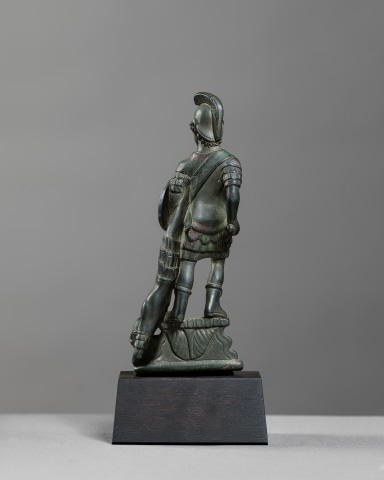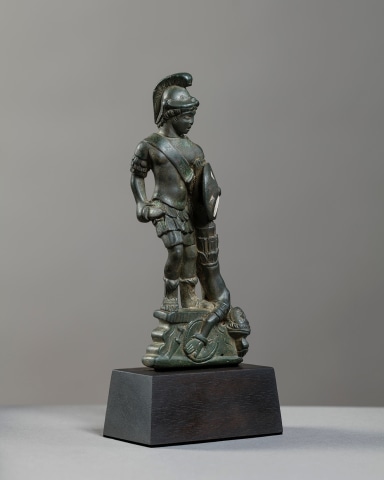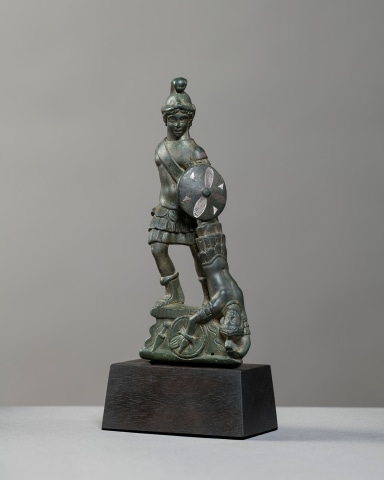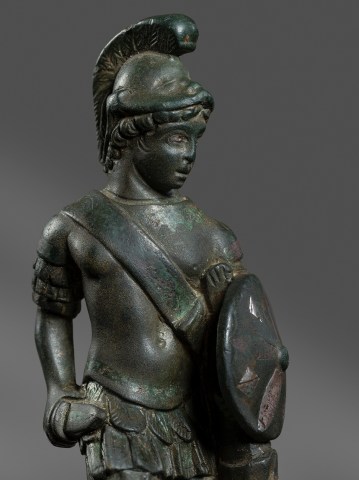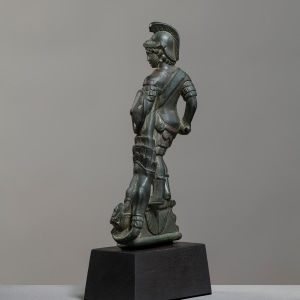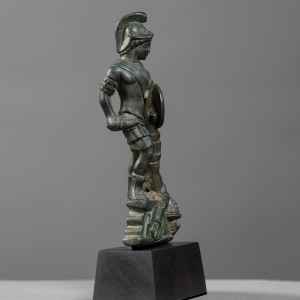Roman sculptural dagger hilt showing Mars Ultor, Gaul, c.1st-2nd century AD
Bronze inlaid with copper and silver
Height: 12cm
11790
Copyright The Artist
£ 45,000
Further images
The sculptural group shows a young, beardless, Mars Ultor (the 'Avenger'), lifting his vanquished enemy feet first. His right leg steps forwards, a short dagger held at waist-height, whilst his...
The sculptural group shows a young, beardless, Mars Ultor (the 'Avenger'), lifting his vanquished enemy feet first. His right leg steps forwards, a short dagger held at waist-height, whilst his gaze turns to the left. He wears a crested anthropomorphic helmet high on his head, showing his thick, short cropped curling hair. The cuirass is moulded with string musculature, a triple layered kilt stops above his knees, open toed, fur lined boots rising up his calfs. The helmet and boots were not worn by Roman soldiers, and are the main indicators that this figure can be identified as the god of war. Silver inlay has been used for his eyes, and to decorate the circular shield that he holds in his left hand, and uses to help secure the feet of his vanquished enemy. Inlay, perhaps of copper and one other metal, has now turned green and red, and was used to decorate the shield, his cuirass and kilt, and the sword strap that is secured over his right shoulder. The inlay was also used to highlight the slash in the vanquished's neck, indicating blood which has run down onto his own cuirass. The vanquished hangs lifelessly, his eyes shut, his wrist through the strap at the back of his circular shield. Mars stands on a hollowed-out pedestal which once acted as a socket for the blade. Intact. A smooth green patina to most of the bronze the inlays clearly visible,, a couple of small nicks show the brighter metal beneath,
a minuscule casting fault at the bottom of the base at the front.
a minuscule casting fault at the bottom of the base at the front.
Provenance
Spink & Son, Ltd, London, UKPrivate collection, UK; acquired from the above in the 1960s-1970s
Literature
The more usual version of Mars Ultor shows the god with his right arm raised, however an example of a Gallo-Roman statuette of Mars with his arms at waist height has been found at a sanctuary outside of Rennes in Brittany.Sculptural, decorative hilts such as this are known, but we have been unable to find any of such high quality as the present example. For the genre compare Laure de Chavagnac and Benoît Mille (eds.), Nouveaux, Regards Sur le Tresor des Bronzes de Bavay (2019), p.110, no.5, and also Heinz Menzel, Die Römishcen Bronzen aus Deutschland I Speyer (Mainz am Rhein, 1960), no.41-44. For a small scale bronze of Mercury, made in the same style also with inlaid silver eyes, compare Laure de Chavagnac and Benoît Mille (eds.), Nouveaux, Regards Sur le Tresor des Bronzes de Bavay (2019), p.136, no.1

